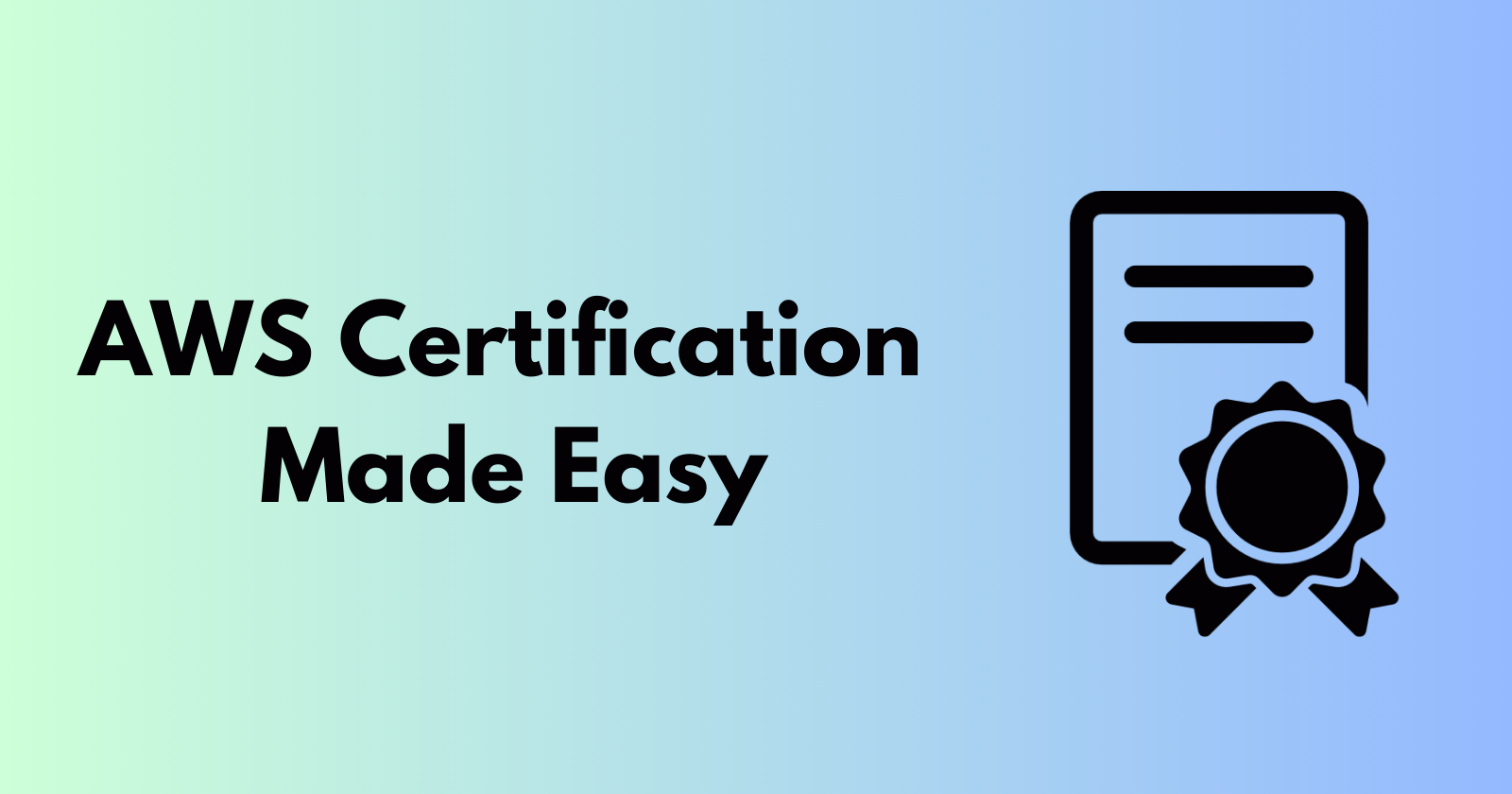AWS Certification Made Easy: Follow These 5 Steps
 Nikunj Vaishnav
Nikunj VaishnavTable of contents
- 1. Strategic Planning and Goal Setting
- Choosing the Right Certification
- Crafting Your Roadmap
- 2. Engaging with High-Quality Training Resources
- What to Look for in Training Courses
- Supplementing with Additional Resources
- 3. Practice, Practice, Practice
- Maximizing Practice Exam Benefits
- 4. Scheduling and Preparing for the Exam
- Final Preparations
- 5. Exam Day and Beyond
- After the Exam
- Conclusion


Earning Amazon Web Services (AWS) certifications is a sought-after goal for many IT professionals, marking a significant milestone in their career journey within the cloud computing domain. AWS, a leader in cloud services, offers a wide range of certifications catering to diverse roles, from architects and developers to operations staff.
AWS certifications are not only a badge of honor but also a testament to the holder’s expertise in utilizing AWS to innovate and solve real-world problems.
Here’s a comprehensive guide on how to navigate the AWS certification process, packed with insights to help you achieve success.
1. Strategic Planning and Goal Setting
Achieving an AWS certification starts with a well-thought-out plan. The journey to certification is a marathon, not a sprint, requiring dedication and strategic preparation.
First, identify which AWS certification aligns with your career aspirations or current job role. AWS offers certifications across foundational, associate, professional, and specialty levels, each designed for specific career paths.
Choosing the Right Certification
Foundational Level: Ideal for beginners, the AWS Certified Cloud Practitioner certification covers basic cloud concepts and AWS services.
Associate Level: Targeted at roles like AWS Solutions Architect, AWS Developer Associate, and AWS SysOps Administrator, these certifications dive deeper into designing, deploying, and managing applications on AWS.
Professional Level: Aimed at seasoned cloud professionals, these certifications demand a comprehensive understanding of AWS services and best practices.
Specialty Level: These certifications focus on specialized areas like Advanced Networking, Security, Machine Learning, and Database.
Crafting Your Roadmap
Outline a detailed study plan, setting realistic deadlines for each phase of your preparation. Incorporate buffer times for unexpected delays and ensure your plan allows for a balanced approach, combining work, study, and personal time. If aiming for multiple certifications, prioritize them based on your career needs or the foundational knowledge required for advanced certifications.
2. Engaging with High-Quality Training Resources
Selecting the right training material is crucial. The ideal resources should comprehensively cover AWS concepts, practical applications, and exam-specific knowledge.
Given the dynamic nature of cloud services, ensure the content is current and reflects the latest AWS features and best practices.
What to Look for in Training Courses
Comprehensive Coverage: Choose courses that thoroughly cover the exam blueprint, offering both theoretical insights and practical applications.
Up-to-Date Content: With AWS frequently updating its services, the course material should be regularly revised to stay relevant.
Learning Style Compatibility: Whether you prefer video tutorials, hands-on labs, or reading materials, the training should match your learning style, making the study process more effective and engaging.
The courses created by Digital Cloud Training are designed to maximize your learning experience and chances of success. Check out our learning library to start your journey.
Supplementing with Additional Resources
Beyond formal training courses, supplement your learning with AWS whitepapers, FAQs, and the AWS documentation. Engaging with the AWS community through forums, study groups, and social media can provide additional insights and tips.
3. Practice, Practice, Practice
Practice exams are invaluable in preparing for the AWS certification tests. They familiarize you with the exam format, question styles, and time constraints. More importantly, they help identify knowledge gaps, allowing you to focus your studies more effectively.
Maximizing Practice Exam Benefits
Variety and Volume: Undertake a variety of practice exams to expose yourself to as many question types and scenarios as possible. Regular practice under timed conditions will enhance your ability to manage the actual exam’s time pressures.
Analyze and Learn: Review each practice exam thoroughly. Understanding why an answer is correct or incorrect solidifies your knowledge and aids in retaining information.
Consistency: Integrate practice exams into your study routine early on, gradually increasing frequency as you approach your exam date.
4. Scheduling and Preparing for the Exam
When you’re consistently scoring well on practice exams and feeling confident about the material, it’s time to schedule your certification exam. Choosing a date sets a concrete target for your efforts, shifting your preparation into high gear.
Final Preparations
Review Weak Areas: Use the time leading up to the exam to focus on areas where you’re less confident. Deep dives into specific services or concepts can clarify lingering doubts.
Relax and Regroup: In the final days before the exam, balance review with rest. A clear, rested mind will serve you better than last-minute cramming.
5. Exam Day and Beyond
The day has arrived to put your knowledge and preparation to the test. Approach the exam with confidence, knowing you’ve prepared thoroughly. Read each question carefully, manage your time efficiently, and remember, educated guesses are better than leaving questions unanswered.
After the Exam
Pass or fail, each exam attempt is a learning experience. If successful, celebrate your achievement and consider your next steps in the AWS ecosystem. If you don’t pass, assess areas for improvement and plan your retake with a focus on addressing knowledge gaps.
Conclusion
Earning an AWS certification is a rewarding journey that can significantly enhance your career in cloud computing. By strategically planning your study approach, engaging with high-quality training resources, practicing diligently, and preparing thoroughly for the exam, you can achieve your certification goals. Remember, each step you take not only brings you closer to certification but also deepens your understanding and expertise in AWS, positioning you for greater opportunities in the ever-evolving cloud landscape. Whether you pass on the first attempt or need to try again, every effort is a valuable learning experience that contributes to your professional growth.
Connect and Follow:
Like👍 | Share📲 | Comment💭
Subscribe to my newsletter
Read articles from Nikunj Vaishnav directly inside your inbox. Subscribe to the newsletter, and don't miss out.
Written by

Nikunj Vaishnav
Nikunj Vaishnav
👋 Hi there! I'm Nikunj Vaishnav, a passionate QA engineer Cloud, and DevOps. I thrive on exploring new technologies and sharing my journey through code. From designing cloud infrastructures to ensuring software quality, I'm deeply involved in CI/CD pipelines, automated testing, and containerization with Docker. I'm always eager to grow in the ever-evolving fields of Software Testing, Cloud and DevOps. My goal is to simplify complex concepts, offer practical tips on automation and testing, and inspire others in the tech community. Let's connect, learn, and build high-quality software together! 📝 Check out my blog for tutorials and insights on cloud infrastructure, QA best practices, and DevOps. Feel free to reach out – I’m always open to discussions, collaborations, and feedback!